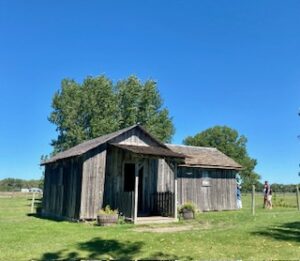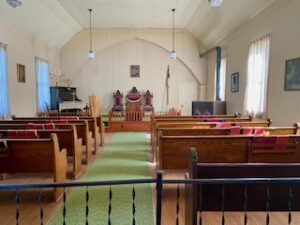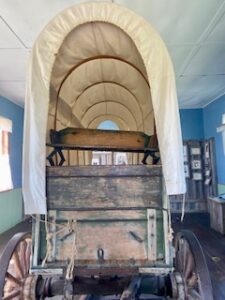
Recently my husband and I took a day trip to visit a several historical sites in South Dakota. We went to Prairie Village west of Madison and two Laura Ingalls Wilder sites at DeSmet.
Prairie Village is comprised of quite a few buildings from the area, ranging from a log cabin built in the 1870s to a school house, an opera house, and a telephone switchboard office. The village also features some railroading history.
The village is located on the shores of Lake Herman and has a lovely view.

We were provided with a map and printed information about most of the buildings, and we could wander at our own pace. It was our first visit to the village. Another time I’d like to see the historic steam carousel, but it was closed the day we visited.
We also visited the Ingalls Homestead site at DeSmet. This was also a first-time visit for us. It’s located on the 160 acre plot south of DeSmet that Charles Ingalls, father of author Laura Ingalls Wilder, claimed in 1880.
The site had an example of a dugout, like what the Ingalls lived in along the bank of Plum Creek in Minnesota, as well as an example of a shanty, similar to what the family would’ve lived in their first summer on their homestead.
I think the shanty looked more pleasant, but it would’ve been very hard to heat in the winter.

Although the site doesn’t have the house the Ingalls lived in, it has a re-created house built to the correct measurements at it’s final addition. The original house would’ve been very tiny for a family of six!
A school building and a church, that came from nearby, are preserved on the homestead even though those buildings don’t have direct connections to the Ingalls or Wilders.
There were docents at the school and the “Little House,” and at the church our wagon driver gave us some information and sung to us from the old song, “The Little Brown Church in the Vale.”
The church and the school buildings are on opposite ends of the land. You may walk if you want, or you may ride in a horse-drawn wagon. The wagon seats probably about 10-12 people, so it’s probably bigger than the wagon the Ingalls would’ve used.
Visitors are allowed to “drive” the tourist wagon — with help from the expert driver. Of course I volunteered, and driving the team of horses was one of the highlights of my day.

We also went to the Laura Ingalls Wilder Historic Homes site in DeSmet. It is comprised of the Surveyors’ House, a couple school houses, and Charles and Caroline’s town house they built after Laura was grown and married.
We had been to this site previously, so instead of visiting the buildings again we went to the “Beyond the Prairie” exhibit at the museum/gift shop. The exhibit focused on the separate and collaborative writings of both Laura and her daughter, Rose Wilder Lane.
It’s well documented how Laura and Rose worked together to write the Little House on the Prairie novel series, but it was very interesting to see their handwritten and typewritten letters to each other discussing the stories and the writing process.
It was also very interesting to learn more about Rose. She was famous before her mother was. Rose was a world traveller, a writer of fiction and non-fiction, and an expert in needlework.
I recommend visiting any of these sites to see what pioneering life was like. Understanding some of the challenges pioneers faced makes me appreciate things like electricity, indoor plumbing, furnaces, modern medicine, gas-powered cars, asphalt roads, and the internet — though it might be fun, once in a while, to take a horse and buggy to town.

Have you been to any of these sites? What’s your favorite part? What part of pioneering would’ve been toughest on you?
-
A Lovely Day at Three South Dakota Prairie Historical Sites
Recently my husband and I took a day trip to visit a several historical sites in South Dakota. We went to Prairie Village west of Madison and two…
-
Join Me for Fun at the Red River Valley Kids Read
Summer Ruins is the featured book for the second annual Red River Valley Kids Read project for libraries in the Fargo, N.D.-Moorhead, Minn., area during March 2023! I’ll speak…
-
Red River Valley Kids Read 2023: Summer Ruins
Summer Ruins is the featured book for the second annual Red River Valley Kids Read project for libraries in the Fargo, N.D.-Moorhead, Minn., area during March 2023! I’ll…
-
New Historical Fiction Connects Readers to Children of the Past
If you’re looking for a newly published historical fiction book for your readers, ages 8-12, I recommend A Kidnapping in Kentucky 1776 by Elizabeth Raum (2022, Chicken Scratch…
-
Elizabeth Goudge Brings Childlike Wonder to Christmas and Epiphany
One of my favorite books I read during the past Christmas and current Epiphany season was I Saw Three Ships By Elizabeth Goudge (published in 1969). This short…
-
History & Imagination in Betsy-Tacy Books Make Delightful Reading Experience
It surprises me when I read a classic book or series that I find I love but that I somehow missed as a kid. I feel like I…
-
A FAMILY BAND by Laura Bower Van Nuys Inspires Resilience and Humor
One reason I love reading about the past is because there are so many inspirational people who faced and overcame challenges. I recently read about the Calvin and…
-
A Blessed Thanksgiving To You!
I do therefore invite my fellow citizens in every part of the United States, and also those who are at sea and those who are sojourning in foreign…
-
Fantasy or History? THE FALL OF GONDOLIN by J.R.R. Tolkien
I’m picky about the fantasy stories I like, but I love J.R.R. Tolkien’s work. He did such a effective job in his world-building that I suspend my disbelief.…
-
2017 Scott O’Dell Award for Historical Fiction: FULL OF BEANS by Jennifer L. Holm
In my quest to read all of the books that have earned the Scott O’Dell Award for Historical Fiction, this month I’ll be talking about the 2017 winner,…
-
Summer Stories Set in the Past Delight Me in the Now
This summer I read two wonderful books that are both considered British children’s classics. I missed them as a kid, so this was my first time to experience…
We create unforgettable experiences by combining your vision with our unmatched skills for standout celebrations.
14-day free trial
